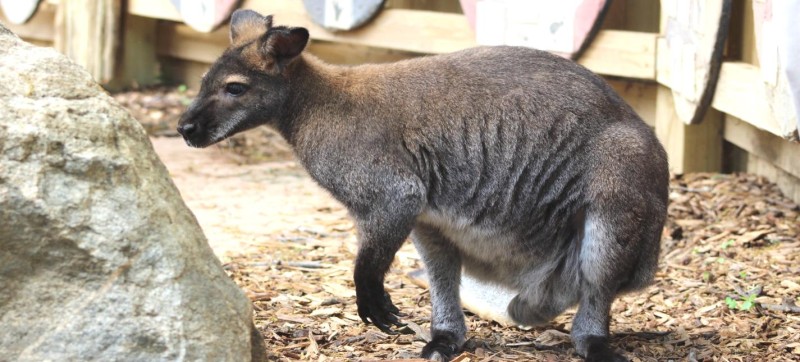Red-Necked Wallaby - Macropus rufogriseus



Habitat:
Red-necked Wallabies are found in coastal scrub forests and sclerophyll (made up of plants that are short, hard, and spiky) forest.
Range:
Eastern Queensland to southeastern South Australia, Tasmania, and islands in the Bass Straight. Introduced to southern New Zealand
Activity Cycle:
Bennett’s wallabies are semi-solitary and most active in the morning and evening, resting during the midday. They are nocturnal in parts of Australia and New Zealand but more crepuscular on Tasmania, demonstrating flexibility depending upon food resources.
Features:
Red-necked Wallabies are distinguished by their black nose and paws, white stripe on the upper lip, and grizzled medium grey coat with a reddish wash across the shoulders. Male: Medium-sized kangaroo like mammal with enlarged hind quarters, short forelimbs and a long, tapered tail. The fur is thick, coarse and often appears shaggy. Female: Smaller than the male with a forward opening pouch.
Size:
Length: Body: 27 – 32 in. ; Tail: 20 – 28 in. ; Weight: Male: 40 lbs. ; Female: 25 lbs.
Social Structure:
The Red-Necked Wallaby is largely solitary, although loose groups, known as mobs, often share common feeding areas. These “mobs” can be up to 30 individuals. Fighting among males is necessary to establish a hierarchy for mating.
Life Expectancy:
approximately 15 years
Diet:
Grasses and herbaceous plants
Reproduction:
Gestation is about 30 days. Female gives birth to undeveloped fetus about ½- ¾ inches long (tic-tac sized). The tiny joey must pull itself 5-6 inches through the mothers fur and into her pouch where it latches on to a teat that swells and fills the joey’s mouth. The wallaby is capable of continuous breeding. This is possible through a process called embryonic diapause, where a second embryo is held in stasis until the first offspring is out of the pouch. Unlike most other mammals, pregnancy does not stop the female from remaining in estrus. She will mate again, and it is the embryo from this mating that is put on hold by the sucking of the first offspring in the pouch. The joey stays suckling for approximately 4 months, and begins to leave the pouch around 6 months. At this time the next egg begins to develop. A female can have up to 3 babies with her at a time: undeveloped embryo, joey in the pouch, and joey out of the pouch. Mother produces milk at varying strengths for the 2 nursing young.
Status:
Least Concern on the IUCN Red List and are part of an AZA Species Survival Plan.
Interesting Facts:
- Baby is called a Joey
- They are marsupials so they have a pouch
- Are so abundant that some consider them pests
- It is one of the largest wallabies and can be easily mistaken for a kangaroo.
- Use their tails as props when they stand on their hind feet and also when they kick with hind feet. They use it for balance when hopping.
- Lick their wrists to cool off during hot weather (blood vessels close to surface)
- A male is called a buck and a female a doe.
- They have 5 clawed fingers, 3 toes: one toe is actually 2 in 1 and has 2 nails that are used like tweezers for grooming.

AZA cooperatively manages this species as a Species Survival Plan® Program.
Video:
Prices
- Adult (13 and over)$12.50
- Child (2 - 12)$9.00
- Child (1 and Under)FREE
- Senior (65+)$11.50
- Active Military$11.50
We begin transferring animals to evening (off exhibit) holding at 4:30 each night.
Find Us
2320 N. Prospect Rd.
Peoria, IL 61603
Phone: 309-686-3365
Open Daily 10:00-5:00
Last admission at 4:30
